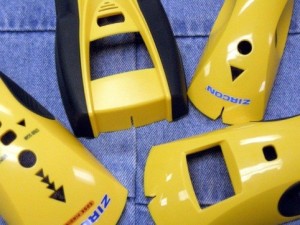“Carbon black, also called charcoal black lamp black, pigment black, soot or black carbon, is a fine particle carbon pigment obtained as soot from the incomplete combustion of many different types of organic materials, such as natural gas, or oil. Carbon black is usually a fine, soft, black powder. It is very stable and unaffected by light, acids and alkalis. It is commonly used in printing and lithograph inks and in Chinese ink sticks. In industry, carbon black is used as a filtration material and a filler /pigment in coatings, rubber, plastics, paints, carbon paper, and crayons. Continue reading
Category Archives: Plastic
How do you validate a APHA/Pt-Co/Hazen 500 liquid color standard?
As described in Section 6 of ASTM D1209, there are 2 criteria to validate a APHA/Pt-Co 500 standard: Continue reading
Is it possible to create ASTM traceable haze standards above 30%?
The current, available ASTM D1003 Haze Standards have nominal Haze% values of 1, 5, 10, 20 and 30 with air (transparent solids) or the transmission cell filled with DI water being 0 (transparent liquids). Here are some thoughts on further options. Continue reading
The details of how HunterLab sphere instruments conform to ASTM D1003 Section 8: Procedure B Spectrophotometer for transmission haze measurement
HunterLab sphere instruments with CIE d/8 geometries conform to the requirements of ASTM D1003 Section 8: Procedure B Spectrophotometer. The measurement of transmission haze using Procedure B instruments will be in close agreement with ASTM D1003 Procedure A Haze meter.
Here is a more detailed description of how the HunterLab UltraScan PRO, UltraScan VIS and ColorQuest XE meet the requirements of Section 8.
How is ASTM D1003 Transmission Haze measured at levels > 30%?
FAQ: “We have a scientist here who is looking at films containing small bubbles and attempting to do measure them by measuring Haze% on a HunterLab spectrophotometer. I suspect her problem in obtaining numbers that “make sense” from what you get from just eyeballing the samples (and trying to look through them at the outlines of a object behind the film to gage the amount of regular transmittance) is that her samples have Haze% > 30 %, which means that a spectrophotometer (or even a haze meter) isn’t the appropriate tool to use for the analysis.
How is transmission haze measured at levels > 30%?”
Measuring Molded Plastic Parts
HunterLab has instrument and sample handling devices to meet almost any customer needs. One such need that we are able to meet is the measurement of molded plastic parts, such as the one pictured above. These plastic parts are actually covers for a stud finder tool. The nature of these parts presents a few difficulties for color measurement. Continue reading
Do you know of an independent test lab that can measure APHA/Pt-Co/Hazen Color?
Contact the following and ask for “APHA/Pt-Co/Hazen Color testing per ASTM D1209 and D5386″.
When do I use Specular Exclusion in Color Measurement?
FAQ: ASTM D6290 recommends that I measure my plastic pellets for yellowness using the specular exclude mode. What is this?
What is a visual limit for Haze%?
FAQ: “What is a visual limit for Haze%? When should I be able to see a difference in a sample?”
A perfect clear of 0% would be air for transparent solids and the transmission cell of a defined path length filled with DI water for transparent liquids.
It should also be noted that the Haze% measurement of scatter in a sample is dependent on the thickness of transparent solid samples or cell path length of liquid samples.
The answer as to when you can see a visual difference will depend on the nature of the sample. For the plastic or glass sheets used in computer tablet screens, acceptable limits for what is faintly visible fall in the 1-2% range.
For pharmaceutical or chemical liquids, the average person may be able to see a visual difference in transmission haze at around 4 – 5%, and should definitely see a difference at a level of 6 – 7%.
To determine this for you sample, you should take a range of products exhibiting haze and get the consensus opinion of a number of people as to which samples show less than and more than visible sample. Measure Haze% using a sphere instrument and assign a visible limit specific to your product.
For many applications, especially those related to consumer products, a visible limit for haze is also the tolerance for acceptable product but not always…
Depending on the end use of the product, what is an acceptable may be below a visible limit if you don’t customer to see any visible haze difference in your product.
Or, if haze is inherent in the product and whatever is causing the product haze does not impact its use, an acceptable tolerance may be several times a visible difference. On these types of products, a typical range for good product might be from 10 to 12%, with an upper limit set at 20% just to ensure that any abnormal product is detected.
Air for transparent solids, or the cell filled with DI water or clear solvent for transparent liquids, is a physical product reference representing no haze, and the best your sample can be. A visible limit in product samples will typically be in the 2% to 5% range. What is acceptable in the marketplace will vary from less than a visible limit to some upper maximum.
ASTM Industrial Test Methods for visual and instrumental APHA Color Scale
FAQ: “Does HunterLab have any documentation to show that the ColorQuest XE is compliant with ASTM 1209. One of our customers is having a problem regarding the method. Their client is using the manual visual method for performing the ASTM 1209 color test method whereas they use the ColorQuest XE. Can you explain the difference?” Continue reading

